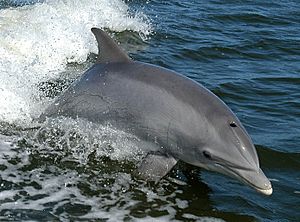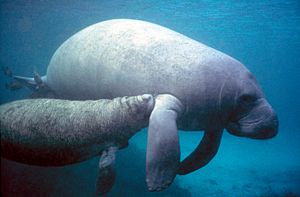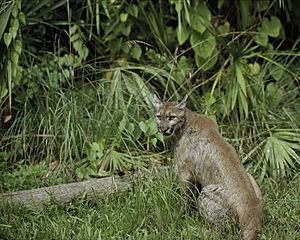Fauna of Florida facts for kids
Florida is host to many types of fauna
Marine mammals: bottlenose dolphin, short-finned pilot whale, North Atlantic right whale, West Indian manatee
Mammals: Florida panther, northern river otter, mink, eastern cottontail rabbit, marsh rabbit, raccoon, striped skunk, squirrel, white-tailed deer, Key deer, bobcats, red fox, gray fox, coyote, wild boar, Florida black bear, nine-banded armadillos, Virginia opossum,
Reptiles: eastern diamondback and pygmy rattlesnakes, gopher tortoise, green and leatherback sea turtles, and eastern indigo snake and fence lizards. In 2012, there were about one million American alligators and 1,500 crocodiles. Birds: peregrine falcon, bald eagle, American flamingo, crested caracara, snail kite, osprey, white and brown pelicans, sea gulls, whooping and sandhill cranes, roseate spoonbill, American white ibis, Florida scrub jay (state endemic), and others. One subspecies of wild turkey, Meleagris gallopavo, namely subspecies osceola, is found only in Florida. The state is a wintering location for many species of eastern North American birds.
As a result of climate change, there have been small numbers of several new species normally native to cooler areas to the north: snowy owls, snow buntings, harlequin ducks, and razorbills. These have been seen in the northern part of the state.
Invertebrates: carpenter ants, termites, American cockroach, Africanized bees, the Miami blue butterfly, and the grizzled mantis. There are 29 species or subspecies of Bees that are endemic within the state of Florida and are not believed to occur anywhere else in the world, including 21 types of pollinators and 8 parasitic species of Bees.
Florida also has more than 500 nonnative animal species and 1,000 nonnative insects found throughout the state. Some exotic species living in Florida include the Burmese python, green iguana, veiled chameleon, Argentine black and white tegu, peacock bass, mayan cichlid, lionfish, White-nosed coati, rhesus macaque, vervet monkey, Cuban tree frog, cane toad, Indian peafowl, monk parakeet, tui parakeet, and many more. Some of these nonnative species do not pose a threat to any native species, but some do threaten the native species of Florida by living in the state and eating them.
The only known calving area for the northern right whale is off the coasts of Florida and Georgia.
The native bear population has risen from a historic low of 300 in the 1970s, to 3,000 in 2011.
Six of Red deer were released on Buck Island Breeding Ranch in Highlands County in 1967 or 1968. The herd increased to less than 30 animals. In 1993, 10 animals were seen in the area, and small numbers have been sighted subsequently in the same area.
In Paynes Prairie Preserve State Park, The plains bison were reintroduced to the park from the Wichita Mountains Wildlife Refuge in 1975, as part of the park service goal of restoring Florida's natural resources to pre-European settler conditions; they roamed this area until the late 18th century. When bison sightings occur, they usually appear along the Cone's Dike trail. The herd was reduced from thirty-five to seven individuals in the mid-1980s after an outbreak of Brucellosis. In the late 1990s, the herd was again reduced after inbreeding concerns. The buffalo herd reached a peak of 70 animals in 2011. The park began culling excessive animals in 2012, allowing a target population of about 8 to 10 bison to be free to roam the Florida prairie.
The American flamingo was also found in South Florida, which was likely the northernmost extent of its distribution. The study also indicated that these flamingos may be increasing in population and reclaiming their lost land. Large flocks of flamingos are still known to visit Florida from time to time, most notably in 2014, when a very large flock of over 147 flamingos temporarily stayed at Stormwater Treatment Area 2, on Lake Okeechobee, with a few returning the following year. From a distance, untrained eyes can also confuse it with the roseate spoonbill.
Since their accidental importation from South America into North America in the 1930s, the red imported fire ant population has increased its territorial range to include most of the southern United States, including Florida. They are more aggressive than most native ant species and have a painful sting.
A number of non-native snakes and lizards have been released in the wild. In 2010, the state created a hunting season for Burmese and Indian pythons, African rock pythons, green anacondas, yellow anacondas, common boas, and Nile monitor lizards. Green iguanas have also established a firm population in the southern part of the state. Due to a combination of events, the green iguana is considered an invasive species in South Florida and is found along the east coast as well as the Gulf Coast of Florida from Key West to Pinellas County.
There are about 500,000 feral pigs in Florida.
Lists
There are a number of invasive species in the state:
- Invasive species
- in the Everglades
- Fish







